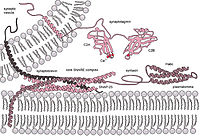
Photo from wikipedia
Mutations in Munc18‐1/STXBP1 (syntaxin‐binding protein 1) are linked to various severe early epileptic encephalopathies and neurodevelopmental disorders. Heterozygous mutations in the STXBP1 gene include missense, nonsense, frameshift, and splice site… Click to show full abstract
Mutations in Munc18‐1/STXBP1 (syntaxin‐binding protein 1) are linked to various severe early epileptic encephalopathies and neurodevelopmental disorders. Heterozygous mutations in the STXBP1 gene include missense, nonsense, frameshift, and splice site mutations, as well as intragenic deletions and duplications and whole‐gene deletions. No genotype–phenotype correlation has been identified so far, and patients are treated by anti‐epileptic drugs because of the lack of a specific disease‐modifying therapy. The molecular disease mechanisms underlying STXBP1‐linked disorders are yet to be fully understood, but both haploinsufficiency and dominant‐negative mechanisms have been proposed. This review focuses on the current understanding of the phenotypic spectrum of STXBP1‐linked disorders, as well as discusses disease mechanisms in the context of the numerous pathways in which STXBP1 functions in the brain. We additionally evaluate the available animal models to study these disorders and highlight potential therapeutic approaches for treating these devastating diseases.
Journal Title: Journal of Neurochemistry
Year Published: 2020
Link to full text (if available)
Share on Social Media: Sign Up to like & get
recommendations!